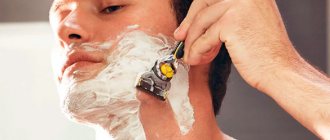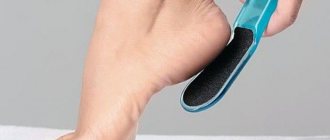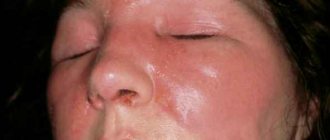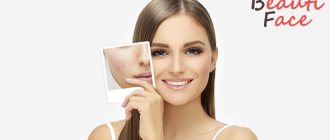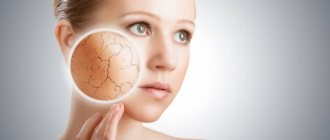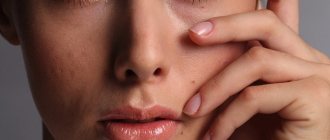Dry facial skin - causes, prevention and treatment
Dry skin (medical name - xerosis, xeroderma) is a condition of the skin in which dehydration occurs. It manifests itself as a feeling of dryness, tightness of the skin, which often shows signs of irritation, peeling, early wrinkles and signs of aging.
Skin is the largest organ of the human body. Its area ranges from 1.5-2.2 m. Like other organs, the skin has its own important functions: thermoregulatory, metabolic, respiratory, excretory, etc. Dry skin is not only a cosmetic defect, but can also indicate various diseases.
The main reason for dry skin lies in the disruption of the sebaceous glands (hypofunction). The lack or absence of sebum production, which, in fact, is the protective layer of the skin from the aggressive external environment, and also which maintains the water balance of the skin, leads to dry skin and its vulnerability to various external influences.
Diagnostics
Peeling and dry skin is accompanied by internal diseases, and therefore, the doctor must take tests to identify specific causes. Sometimes a careful examination of the skin area is sufficient to determine, for example, a disorder of the thyroid gland or abnormal hormone levels.
Skin diseases that are associated with dry skin:
- Ichthyosis - with this disease, skin cells in some areas resemble fish scales. The scales can be white or brown. This disease often causes deep cracks in the palms or soles of the feet;
- follicular keratosis. Accompanied by small pimples, which usually appear on the arms and legs. These pimples give the skin a rather rough, sandpaper-like appearance. But they are almost the same color as the body, sometimes a little reddish;
- psoriasis - this disease is accompanied by characteristic dryness and flaking. The affected areas of the skin become red and covered with scales. Sometimes such a disease is also combined with infections.
Moisture retention mechanism
On the surface of the skin there is a stratum corneum. Its moisture is provided by cellular structures and lipids located between them (fat layer), which perform several functions:
- they act as a bonding agent for intercellular structures;
- prevent moisture loss;
- regulate the rate of skin peeling and cell renewal;
- Thanks to their antimicrobial action, they play a protective role on the surface of the epidermis.
In normal skin, there is a certain balance between the water content in the stratum corneum and in the surrounding air due to the work of the sebaceous glands; if it is disturbed, dry facial skin appears or, conversely, oily.
The water-lipid emulsion film that forms on the surface of the epidermis also contributes to moisture retention. It is formed from secretions of sweat and sebaceous glands and intercellular lipids. An emulsion may have different ratios of components. This depends on external conditions and the intensity of the glands.
Causes of dry skin (xerosis):
- improper care or hygiene;
- insufficient water intake;
- poor nutrition;
- Features of the skin – thin skin;
- deficiency of vitamins in the body (hypovitaminosis), especially vitamin A;
- exposure of the skin to direct sunlight (ultraviolet radiation), incl. visiting a solarium, as well as cold, wind, rain, snow, frost;
- frequent bathing in hot water, daily hot showers;
- use of soap with surfactants (surfactants) for washing the body;
- use of household cleaners and detergents without protective equipment (gloves);
- use of alcohol-based cosmetics;
- hormonal changes in the body, age-related changes;
- long-term use of hormonal agents - systemic and external glucocorticoid drugs;
- metabolic disorders;
- violations of the daily routine, stress, chronic fatigue syndrome, bad habits;
Xerosis, together with other symptoms, can be a symptom of an internal disease, in which dry skin is just the tip of the dangerous “iceberg” that is hidden in your body.
For example, flaky dry skin, itching, the appearance of swelling and pustules indicate problems with metabolism - diabetes, hypothyroidism, as well as other diseases of the endocrine system, skin, gastrointestinal tract: psoriasis, eczema, dermatitis, keratosis pilaris, hepatitis, cirrhosis of the liver, renal failure, chronic intoxication and others. Therefore, if changes in skin care and exclusion of unfavorable environmental factors do not solve the problem, you need to be examined by a doctor.
Skin xerosis. Solving the problem externally
Xerosis is caused by impaired sebum and sweating, a deficiency of amino acids contained in the stratum corneum of the skin, and dehydration. Most often, xerosis appears on the skin of the feet due to an initially small number of sebaceous glands, slow turnover of epithelial cells and a pronounced violation of the protective functions of the skin.
The main cause of dryness is a lack of moisture in the stratum corneum of the skin; with a long-term process, peeling, a feeling of tightness, irritation, microcracks and itching appear.
Dryness occurs due to insufficient care, poor circulation, which is facilitated by constitutional features, wearing tight clothes and tights, tight shoes, insufficient moisture intake, and also due to alkalization of the skin with hygiene products and the use of harsh abrasive products. The problem with dryness most often manifests itself in the autumn-winter period due to the fact that with the onset of cold weather, the feet are constantly in contact with warmer and coarser woolen fabrics and synthetics, and this prevents sufficient air penetration; In addition, seasonal vitamin deficiency affects it. At the same time, problems can also arise in the summer, which is associated with prolonged exposure to the sun and walking barefoot. With proper and regular care, an aesthetically pleasing appearance is achieved. The main causes of skin xerosis and options for their correction are presented in Table 1.
The main pathogenetic mechanisms of increased skin dryness are:
1) a decrease in barrier function due to the failure of the lipids of the stratum corneum, a violation of their structure and location, which causes defects in the intercellular lipid layers, which leads to an increase in transepidermal moisture loss;
2) a decrease in the ability to retain moisture due to a lack of hygroscopic substances inside corneocytes, the so-called natural moisturizing factor (NMF), which consists of free amino acids and their derivatives, lactic acid, urea and other components that create the hydrolipid mantle of the skin [5];
3) disruption of moisture transport from the dermis to the epidermis and stratum corneum.
All this leads to dehydration of the epidermis and the development of a clinical picture of xerosis [1–3].
The group of chronic dermatoses, accompanied by dryness, hyperkeratosis and peeling, includes a large number of skin diseases. These include such common diseases as psoriasis, eczema, atopic dermatitis with lichenification, squamous-hyperkeratotic forms of mycoses, and rare nosological forms - ichthyosis, keratoderma, etc. Xerosis is also characteristic of age-related changes or can be caused by concomitant somatic pathologies - diseases thyroid gland, diabetes mellitus (DM), vitamin deficiency, metabolic disorders.
The process of development of dehydration at the cellular level is presented in Figure 1, and the stages of clinical manifestations during the development of skin xerosis with possible correction methods are shown in Figure 2. It should be noted that these phases can be traced for all manifestations of dry skin, both in chronic dermatoses and for somatic diseases.
Xerosis of the skin of the feet in diabetes is one of the provoking factors of diabetic foot syndrome. Statistics show that the appearance of diabetic foot signs is associated with the stage of decompensation in individuals suffering from type 2 diabetes; manifests itself in 90% of patients [4]. This condition occurs due to angio- and neuropathy of the feet, i.e. destruction of nerves and blood vessels, while tissue nutrition deteriorates, their protective function decreases, and this leads to trophic changes and thereby increases the risk of developing gangrene or ulcers even with minimal injuries. Such patients complain of discomfort in the legs, stabbing and burning pain when the legs are at rest, at night, as well as severe pain when walking. Over time, the sensitivity of the feet noticeably decreases, the color of the skin of the lower extremities changes - it becomes pale or with a slight brownish pigmentation, at the same time dryness, peeling of the skin, cracks, microvesicles with serous contents, as well as thickening of the stratum corneum of the skin of the feet appear. All this shows that xerosis of the skin in diabetes, both due to general dehydration and autonomic diabetic neuropathy with impaired innervation and regulation of the sweat glands, is not only a cosmetic problem, but also one of the links in the development of diabetic foot syndrome.
Dry skin to one degree or another occurs in 85% of patients at the appointment. Therefore, practicing doctors encounter such patients every day, sometimes they make up the majority of adult dermatological appointments. Advances in pharmacology, in particular combined anti-inflammatory drugs with exfoliating components, have significantly improved the quality of life of patients, and their availability and variety in pharmacy chains make it possible to make choices and experiment with treatment methods. Over time, new issues have arisen in the treatment of dermatoses accompanied by hyperkeratoses, namely, the duration of use of combined and monosteroids, anti-relapse and preventive therapy, care for hyperkeratotic conditions and peeling, the correction of which is initially difficult due to genetic “breakage” or due to concomitant diseases.
Currently, there is a reassessment of the importance of cosmeceuticals in the therapy and care of the skin of patients with xerosis, chronic dermatoses, and diabetes. There are a number of modern lines of medical cosmetics for skin care for hyperkeratosis, which have proven themselves, are widely available for everyday use and often have a pronounced softening, exfoliating and moisturizing effect. Basic drugs, most often based on topical steroids, have high expectations in terms of their antiproliferative, resolving, antipruritic, anti-inflammatory, antibacterial and healing effects. But such properties, while maintaining a softening, moisturizing and exfoliating effect, are also inherent in classic dermatropic components with metabolic, hydrating and softening effects: urea, various acids, panthenol, complexes of oils, alkaloids and flavonoids.
To successfully combat dry feet, you first need to find out the cause of its occurrence. Diagnosis of dry skin involves excluding fungal infections, various endocrinopathies, skin diseases, and identifying the causes of xerosis. If the cause is any disease, then it is necessary to first cure it or correct the condition, and then deal with the manifestations. In some cases, with a severe inflammatory reaction, the prescription of glucocorticosteroid or combination creams with the parallel use of care products is required. But sometimes the use of moisturizers, which have pronounced effectiveness in treating dryness of various origins, high organoleptic properties, a high safety profile and good tolerability, leads to the desired result. At the same time, it has been clinically proven that anti-inflammatory drugs in combination with emollients are more effective than monotherapy with glucocorticosteroids. Thus, one of the main tasks when the skin barrier function is impaired is protection and hydration. Examples of products that effectively solve these problems are foot balms Balzamed and Balzamed intensive (Esparma GmbH, Germany), which are recommended for daily care of dry and sensitive skin of the feet, prone to redness, irritation, the formation of chafing and calluses, especially in patients with diabetes. .
Balzamed balms provide the skin of the feet with sufficient hydration and nutrition, preventing the formation of chafing and calluses, the appearance of peeling, redness and irritation on the skin of the feet. Balzamed balms contain a balanced composition of vital vitamins, moisturizing components and softening vegetable oils.
Balzamed and Balzamed intensive balms contain the following components:
Vitamin A, which protects against excessive keratinization and increases the skin's resistance to infections, protects it from the formation of microcracks, slows down the aging process, improves its elasticity and general condition.
Vitamin E (tocopherol acetate) is an antioxidant, binds free radicals, protects skin cells from metabolic damage caused by metabolic disorders, as well as from external environmental influences, helps reduce skin itching.
Vitamin F increases skin elasticity, regulates moisture content, and promotes rapid healing of microcracks.
Provitamin B5 (panthenol) accelerates the healing of small wounds, maintains water balance and skin resistance to external environmental influences, stimulates the regeneration of skin and mucous membranes, normalizes cellular metabolism, accelerates mitosis and increases the strength of collagen fibers, has a regenerating and anti-inflammatory effect.
Lactic acid promotes exfoliation and hydration, faster cell renewal.
Urea increases the absorption of water by keratinized areas of the skin, actively moisturizes dry skin and increases its permeability to vitamins, and also protects against external environmental influences; easily penetrates into the deep layers of the epidermis and serves as a conductor for other active components; has keratolytic, wound healing and bacteriostatic effects.
Avocado and jojoba oils contain vitamins A, B, D, E and K, soften, moisturize and nourish the skin, have a protective effect, restore skin elasticity, and prevent premature aging.
Zinc stearate, which is part of Balzamed intensive, stabilizes the skin of the feet and promotes healing.
Thus, the components included in the balms Balzamed and Balzamed intensive have a pronounced anti-inflammatory, antipruritic, exfoliating and antimicrobial effect, help restore damaged skin, increase the regenerative and barrier functions of the skin, prevent the feeling of dryness and irritation, relieve itching, promote hydration and restoration of affected areas of the epidermis. These drugs can be used both in complex therapy with anti-inflammatory glucocorticosteroid drugs, and independently, as a means of daily skin care.
In order to achieve maximum positive results, it is recommended to apply the foot balm daily to the damp skin of the feet, especially to areas subject to pressure and friction, rubbing in with light massaging movements.
Regular care of the skin of the feet using Balzamed will prevent the appearance of peeling, redness and irritation on the feet, the formation of corns and calluses, give elasticity and firmness to the skin, and prevent premature aging.
Skin xerosis is, as a rule, cyclical in nature with periods of deterioration, especially in the autumn-winter period, and therefore foot balms Balzamed and Balzamed intensive are the main links in both therapeutic and preventive care for the skin of the feet and allow you to completely cope with the problem of dry skin , including with such serious concomitant diseases as diabetes.
Symptoms of xerosis
The main symptoms of xerosis (xeroderma) are:
- dryness, tightness and irritation of the skin;
- the presence of peeling, roughness on the skin;
- the appearance of cracks in the skin, especially in places of bends/folds - fingers, elbows, knees;
- frequent redness and skin irritation, which often occurs after skin contact with cold, water, soap;
- almost invisible pores;
- the presence of wrinkles at an early age;
- a feeling of itching of the skin, sometimes severe, as well as a burning sensation.
Symptoms
Often, xerosis is a temporary problem that worries only during a certain period of the year, although it can occur throughout life. The manifestation of the problem and its characteristic symptoms depend on age, general health of the body and on living in a certain place.
The most common symptoms are:
- redness of the skin, possibly in some areas;
- a feeling of tightness of the skin, observed especially after a bath;
- skin cracks of various types;
- dehydrated and wrinkled skin;
- roughness;
- itching;
- peeling.
If the manifestation of the problem disrupts the usual routine of life, then you need to consult a doctor. This should usually be done when itching or dryness makes it difficult to sleep, the skin condition does not improve with certain measures, or there is severe flaking of the skin accompanied by redness or ulcers.
Rules of care
Any skin requires careful care, but dry skin in particular. It is necessary to provide competent and regular care, which requires compliance with several conditions.
- In the morning, water washes away from the face all the fat released overnight from the sebaceous glands, and deprives the skin of the protective barrier it so needs during the day. Therefore, it is better to postpone the thorough washing procedure to the evening.
- A dry face should be washed with water at room temperature, and the bath or shower should be warm.
- Water quality is important. It needs to be boiled and cooled or used filtered, thawed or settled.
- To wash your face, you can only use moisturizing gel or foam. Any soap should be excluded.
- You should not rub your wet face with a towel; it is better to let it dry or lightly blot it with a soft cloth.
- Very dry facial skin requires especially careful selection of cosmetic care products. If you do not make such products from natural products, it is better to buy cosmetics from well-known manufacturers and, preferably, from the same series, with a note indicating that they are intended for dry skin. It is necessary to avoid gels and lotions containing alcohol. It has a drying effect on the skin.
- You need to carefully select decorative cosmetics. Both creams and powders must have moisturizing properties and contain protective filters.
- It is also important how to remove makeup - it can only be removed with special cosmetics intended for this purpose. You should not leave makeup on your face overnight.
- It is important to replenish the lack of water in the body. Drinking plenty of fluids daily will not only increase skin moisture, but also remove metabolic products and toxins. This will help cleanse the skin and give it a fresh and healthy look. It is recommended to consume up to two liters of water per day.
- A balanced diet is an important part of the fight against dry skin. An increase in fruits and vegetables in the diet contributes to:
- timely cleansing of the intestines and rapid removal of toxins from the body;
- the body receives vitamins and nutrients involved in healthy skin.
- It is necessary to monitor the humidity level at home and at work. If the air in the room is too dry, you should install a humidifier in it and regularly ventilate the room.
- Excessive sweating is not recommended, so you should think about the choice of sport. Swimming pools with chlorinated water also have a negative effect: before swimming, it is better to apply a rich cream to the skin.
Since it is quite difficult to get rid of dry skin on the face, you need to tune in to long-term and systematic care in compliance with all the recommendations listed.
Treatment
If a person is bothered by itching and dry skin, they should consult a doctor.
When there are serious skin problems: psoriasis or atopic dermatitis, creams and ointments are used that contain corticosteroids - Advantan, Elokom, Celestoderm B. Sometimes antibiotics may be included in the treatment, especially if the cause could be an infection.
Naturally, if the skin is dry, then it is not always possible to achieve the desired result - flawless skin:
- Take hot baths less often, lasting no more than 15 minutes. In addition, it is much better to use warm water;
- moisturize the skin, for this there are now many products that help retain moisture in the skin for a long time. Especially effective is oil for newborns;
- do not forget about a humidifier, since dry air often dries out the skin, so it is advisable to use at least a portable humidifier;
- Avoid harsh and harsh soaps and don’t think about skimping on skin cleansers. It is advisable to use soap containing oils;
- choose clothes made from natural fibers;
- After bathing, use moisturizers and lightly dry your skin with a towel.
Improved skin hydration
A number of cosmetic procedures help combat facial skin dehydration. The most common of them are skincare procedures (cleansing, masks, facial massages), as well as deeper impact procedures: peelings, PRP plasma therapy, mesotherapy, bioreparation and biorevitalization.
The choice of the optimal method is carried out by the cosmetologist together with the patient based on the clinical picture at the preliminary appointment.
Facial mesotherapy is microinjections of a medicinal product based on hyaluronic acid in the form of individually selected cocktails, which are injected into the middle layer of the skin. Such cocktails may include minerals and vitamins, extracts of medicinal plants, amino acids and other substances.
Mesotherapy acts from the inside and promotes the active launch of skin regeneration and hydration processes. As a result, its rejuvenation occurs, the complexion improves, the skin becomes more elastic, and the oval of the face becomes clearer.
Biorevitalization is an injection of drugs based on a natural antioxidant - hyaluronic acid. The doctor injects hyaluronic acid into the patient using microinjections, replenishing its deficiency. By attracting and holding water molecules, hyaluronic acid saturates the skin with moisture, as a result of which it becomes smoother and more radiant, and wrinkles are smoothed out. Moreover, the procedure stimulates its own synthesis of acid, collagen and elastin, affects the activity of fibroblasts, so the effect does not go away after a week or two, but lasts up to 6-8 months, depending on the individual characteristics of the patient.
Bioreparation is the latest technique for rejuvenating the face, neck, décolleté (as well as other areas of the body) thanks to the intradermal administration of biosynthesized hyaluronic acid preparations in combination with vitamins, minerals, peptides and amino acids. The advantage of the modified drug is that it is less sensitive to the enzyme that destroys hyaluronic acid (hyaluronidase), which means the effect lasts much longer. In addition, the preparations for bioreparation include a vitamin-mineral complex, amino acids and peptide compounds that stimulate the production of collagen and create a supply of nutrients.
PRP plasma therapy RegenLab
RegenLab plasma therapy is an injection technique for introducing autoplasma into the dermis, prepared from the patient’s own venous blood, purified and enriched with platelets.
The purpose of the procedure is to stimulate cell regeneration, moisturize and restore the skin's immune system, restore damaged tissues naturally, and rejuvenate the skin by stimulating the body's own resources.
This is one of the safest procedures, because... the risk of drug rejection and infection is practically reduced to zero.
How does this happen?
The procedure is carried out in a cosmetology salon. In this case, the specialist performs several stages of therapy, these include: 1. Taking blood from a vein (on average up to 15 ml). 2. Obtaining platelet-rich plasma. 3. Inject the prepared PRP into the areas of the skin that need treatment. Typically, thin atraumatic needles are used, which reduce the level of discomfort and discomfort during therapy. If necessary, the doctor applies pain relief with a special cream. Therapy lasts no more than 40 minutes. It is completely painless and goes away without any negative feelings. However, after plasma administration, the skin may remain swollen and red for some time. Soon these symptoms will disappear on their own and the first noticeable positive effect of plasma lifting will appear.
What happens next? Several million platelets that have been injected into the skin are activated and interact with fibrin. As a result of their joint work, a fibrin framework is formed in the skin from biologically active platelets and fibrin.
Platelets contain alpha granules, which only at a sufficiently high concentration release growth factors: platelet-derived growth factor, transforming growth factor, vascular endothelial growth factor, epithelial growth factor, which trigger the following processes:
- There is an effect on stem cells, which trigger the processes of tissue regeneration (restoration).
- The antioxidant system is activated, oxygen saturation of cells is improved, and inflammatory processes are suppressed.
- Skin macrophages are stimulated, local immune defense is increased.
As a result, dryness and sagging of the skin are reduced, skin color is improved, firmness and elasticity are increased, the intensity of hyperpigmentation is reduced, the relief is evened out and wrinkles are eliminated, which are smoothed out naturally. This is a significant difference in the use of bioactive plasma from synthetic gels.
Peelings
The action of peelings is designed to activate the ability of tissues and cells to heal themselves. As a result of these procedures, microcirculation can improve and the production of elastin and collagen can be activated. The following types of peelings will help improve hydration:
- mechanical (biodermabrasion);
- hardware (gas-liquid, ultrasonic peelings);
- chemical (glycolic peeling or TCA peeling).
This procedure can be combined with other cosmetic techniques, but between sessions it is necessary to maintain the time period recommended by the doctor.
Still have questions? Call! .
Sign up for a free consultation with a cosmetologist with digital skin diagnostics and ultrasound skin diagnostics.
Our specialists will conduct a detailed analysis of the data obtained and select the most suitable treatment for you, taking into account individual characteristics and financial capabilities, or develop a personal program of procedures.
By combining injection and/or hardware cosmetic procedures, you will achieve maximum results. This means delaying the manifestation of age-related changes for several years!
Our doctors have extensive experience and a light hand! Attention, care and comfort during the procedure are guaranteed!
